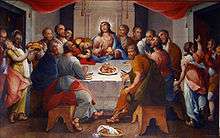Manoel da Costa Ataíde
| Manuel da Costa Ataíde | |
|---|---|
| Born |
October 18, 1762 Mariana, Minas Gerais, Brazil |
| Died |
February 2, 1830 (aged 67) Mariana, Minas Gerais, Brazil |
| Nationality | Brazilian |
| Known for | Painting and Sculpture |
| Movement | Baroque and Rococo |


Manuel da Costa Ataíde, better known as Mestre Ataíde (1762 to 1830), was a Brazilian painter, sculptor, gilder and teacher.
He was an important artist of the baroque-rococo school in Minas Gerais and had a major influence on painting in the region, with many students and followers. His method of composition, particularly in perspective works on church ceilings, continued to be used until the middle of the nineteenth century. Contemporary documents often refer to him as a teacher of painting. In 1818 Ataíde tried without success to obtain official permission to found an art school in Mariana, his home town. He owned technical manuals and theoretical tracts such as Andrea Pozzo's "Perspectivae Pictorum Architectorum" from which he must have studied technique.
His art is characterised by the use of bright colours, especially blue.
He was a contemporary and colleague of Antônio Francisco Lisboa (Aleijadinho). In the period 1781 to 1818 he completed and gilded Aleijadinho’s images for the Sanctuary of Bom Jesus de Matosinhos in Congonhas.
Works
- Painting of the chapel of Nossa Senhora da Glória of 1742 in Ressaca, Carandai, Minas Gerais.
- Paintings in the Church of Saint Francis of Assisi in Ouro Preto carried out between 1801 and 1812. The "glorification of the Virgin", painted on wood in the roof of the main nave, his best known work.
- Interior of the presbytery of the Church of St. Anthony in Santa Barbara, 1806;
- "The Last Supper" in the college of Caraça, 1828;
- Ceiling of the presbytery of the Church of St Anthony in Itaverava, 1811;
- Ceiling of the presbytery of the Church of Our Lady of the Rosary, in Mariana, 1823.